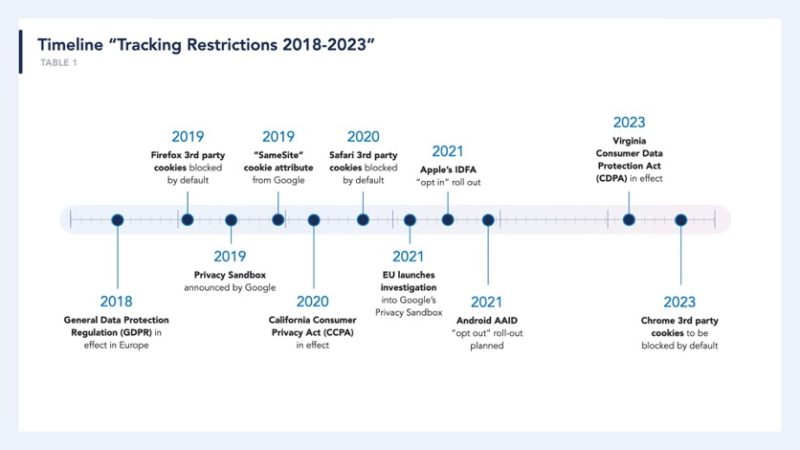
SEO and the future world without third-party cookies
Third-party cookie tracking is going away, and the SEO industry is ready and diligently preparing ambivalent and posting memes on Twitter.
SEO has been dealing with the lack of cookie tracking since its existence.
So does the cookie’s demise actually matter?
Well, my friends, I’m here to tell you two things.
The good news: this change means something and there’s an opportunity.
The bad news: it’s not going to be easy.
It takes some smart chops to get done, plus considerable resources you’re not likely to get sitting over there in the SEO corner of the office (remote, of course).
Contents [show]
What’s the situation?
Legislation, such as the EU General Data Protection Regulation (GDPR) and the California Consumer Privacy Act (CCPA), are tightening up how advertisers can use to track users.
I think the claim behind this initiative – that consumers want more control of their data – is partly valid but not tremendous.
Most users don’t care and don’t think about who’s tracking them, except in passing. It’s not a concern that causes them to change their online behavior unless they’re trying to hide something.
Most of us would prefer to have clarity and reasonable limits on what an advertiser can track and how they target us. But in general, I’ve found we leave it at that.
The average user doesn’t think much about it, especially since it gets technical and specialized quickly, and more so by the year.
But these privacy restrictions are coming and they’re a good thing.
Have you noticed, for example, the rise of auditory targeted ads and content you’re being delivered by Google?
Try an experiment some time in your home.
Start talking about a random but specific topic and repeat the keyword(s) a few times.
You’re likely to find it in your news feed, in ads, in search results, and sprinkled around in the most unusual “recommended” places.
Freaky? Yeah, kinda…
It’s probably good we’ve got legislation setting some limits, however, limited they are at this early stage.
It’s not new, anyway. The focus on cookies has been happening for years.
For example, Firefox began blocking third-party cookies as early as 2019. Safari followed suit in 2020.

As the move to a cookieless future gains force and creates greater restrictions in digital advertising, SEO needs to keep pace.
We need to get a seat at the table, especially with regard to the measurement of channel effectiveness, attribution, and yes, incrementality (I said it!).
The latter is a big word – and a difficult thing to do in SEO.
Historical measurement models
Traditional measurement models that leverage cookies, such as multi-touch attribution (MTA), will be increasingly phased out of analytics toolkits.
The two primary models marketers have historically used are media mix modeling (MMM) and MTA.
MMM is a top-down approach that typically covers multiple years of data, while MTA is a bottom-up approach, more granular, and reliant upon cookies to track sessions and users.
The problems with cookies are of some significance, too. They fail to measure cross-device, and more recently, they’re opt-in only.
But marketers still need to measure performance. Cookies have been handy for that.
Next-level ideas for tracking SEO
When considering how a cookieless future impacts SEO, follow the model already set forth by other measurement channels: build a clean room.
The reality is that a clean room probably will not be built specifically for SEO. It doesn’t need to be – since SEO doesn’t have first-party data, anyway.
This is where the hard reality of SEO relative to other channels becomes apparent. Measuring it will not lead to the investment of resources across an organization. Not by itself, anyway.
But you can leverage the work others have done in paid media, for example, to get some interesting measurement applications for SEO.
Aggregated attribution
Rather than using individual data, this approach takes a high-frequency metric (i.e., organic search sessions) and examines how other media (i.e., TV spots) impacts the channel.
This type of analysis provides insight into how SEO captures the demand created by a TV ad, offline campaign, or display campaign.
Modified media mix modeling
Trying to force organic clicks into media mix modeling (MMM) is a misapplication of the metric due to the fact you’ll be changing the results already reported to the organization.
The paid media team would disagree, and the organization would be distracted and potentially stuck in arguments over attribution.
Instead, we can take the MMM and set aside all the sales driven by media. Then, we can run SEO clicks against the base sales to attempt to tease out the signal of SEO that is hiding in the base.
Additionally, we can consider running a model of paid media impressions against SEO clicks to understand media interaction.
This is similar to the aggregated attribution approach but more granular.
Get the daily newsletter search marketers rely on.
Additional considerations
We have to balance the reality of how much teams are willing to invest in tracking the effectiveness of SEO, relative to other channels.
There is a lot of money pouring into media, obviously, and this drives heavy innovation into media mix modeling and attribution for these channels.
The same cannot be said for SEO. But we need to find ways to measure SEO’s effectiveness, and it needs to be sophisticated in line with other channels’ approaches today.
Gone are the days of relying on some third-party Semrush charts, except in cases perhaps where we’re looking at competitive insights.
It may very well be that existing MMM solutions already have adequate insights available to them that include owned and earned observations without risking what analytics teams call, “collinearity,” the phenomenon of insights being skewed from data sets that are dependently correlated (i.e., linear) when sliced and diced.
Another consideration is that teams may simply not need, or have the budget for, complex modeling such as MMM. In these cases, perhaps Google Analytics 4 and Adobe do everything that’s needed at a basic level, which can be augmented with some SEO testing.
Conclusion
The answer to all this is simple but hard to accomplish.
SEO as a channel famously plays second fiddle to media – be it paid search, display or paid social.
Yes, companies invest in SEO and care about SEO.
When everything else is accounted for, however, media dollars will always take precedence in any measurement conversations.
Resources follow the money, and SEO is on the short end of the stick when it comes to resources from the analytics and data science teams.
But it doesn’t have to be.
Getting SEO data sets into the clean rooms and aligning them to other data sources is key for gaining insights into the channel.
As digital marketers move toward using clean rooms such as Google Ads Data Hub (ADH) and others, SEO teams need to get site analytics data into these environments.
By bringing the data together, SEOs can look at customer journeys across paid media impressions, clicks and site activity (including a tag for source as organic search).
In this new environment with SEO analytics data added to a clean room, marketers can also get toward an attribution use case to measure the contribution and even the incrementality of the SEO channel and its relationship with the other channels.
But there’s a difficult catch here. The reason it’s hard is that generating buy-in from others is essential.
There’s already enough focus and resources centered on this transition away from cookies toward clean rooms and more trackable solutions.
This means resources aren’t sitting around (usually) waiting to accommodate SEO. And most marketers won’t have the interest to rank SEO priorities above media, especially when it comes to things like attribution and channel performance measurement.
But that’s exactly what we need as SEOs more than ever: good performance tracking.
And we especially need SEO’s contribution, and yes, incremental addition to the cross-channel picture.
Doing this successfully is part of the SEO’s world: navigating resources and teams along with generating buy-in from the right groups to prioritize this work.
If you can do that, the entire organization will benefit from greater clarity of SEO’s contribution and its value to the business.
Opinions expressed in this article are those of the guest author and not necessarily Search Engine Land. Staff authors are listed here.
New on Search Engine Land
About The Author

Adam Audette is SVP SEO and Data Science at Blend360. Adam started his career in the early 2000s by co-founding the SEO agency AudetteMedia. He was the global head of SEO for Merkle / Dentsu for nearly eight years. He now works at Blend360 combining the worlds of data science and SEO. Adam and his teams have worked with many of the world’s leading brands, including Google, Facebook, Amazon, Zappos, Walmart, Target, Experian, Samsung, Walgreens, and many others.




